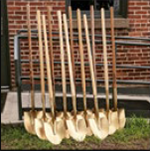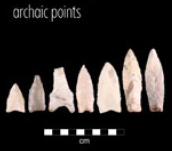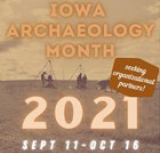
Previous Years
Office of the State Archaeologist annual reports from 2010 through the last fiscal year are archived in the University of Iowa Digital Library. They are viewable in PDF format.
FY 2022 Annual Report: PDF Versions
The PDF versions of our annual reports span two volumes. They are interactive and contain more imagery and comprehensive tables.
FY 2022 Annual Report Vol. 2
A compilation of metrics concerning OSA activities of the past fiscal year.
FY2022 OSA Annual Report: Web Version
WHO WE ARE
ACADEMIC ACTIVITIES

First-Year Seminar: Archaeology and History in American Cemeteries
Jennifer Mack | Bioarchaeological Assistant Instructor
Students explored the wealth and variety of information that can be gleaned from historic American cemeteries both from above ground observations and below ground excavations. Students learned from archaeology, history, art, genealogical research, skeletal analysis, and even botany, and discussed issues such as historic preservation and the sacredness of the dead. [Fall 2021, 17 students]
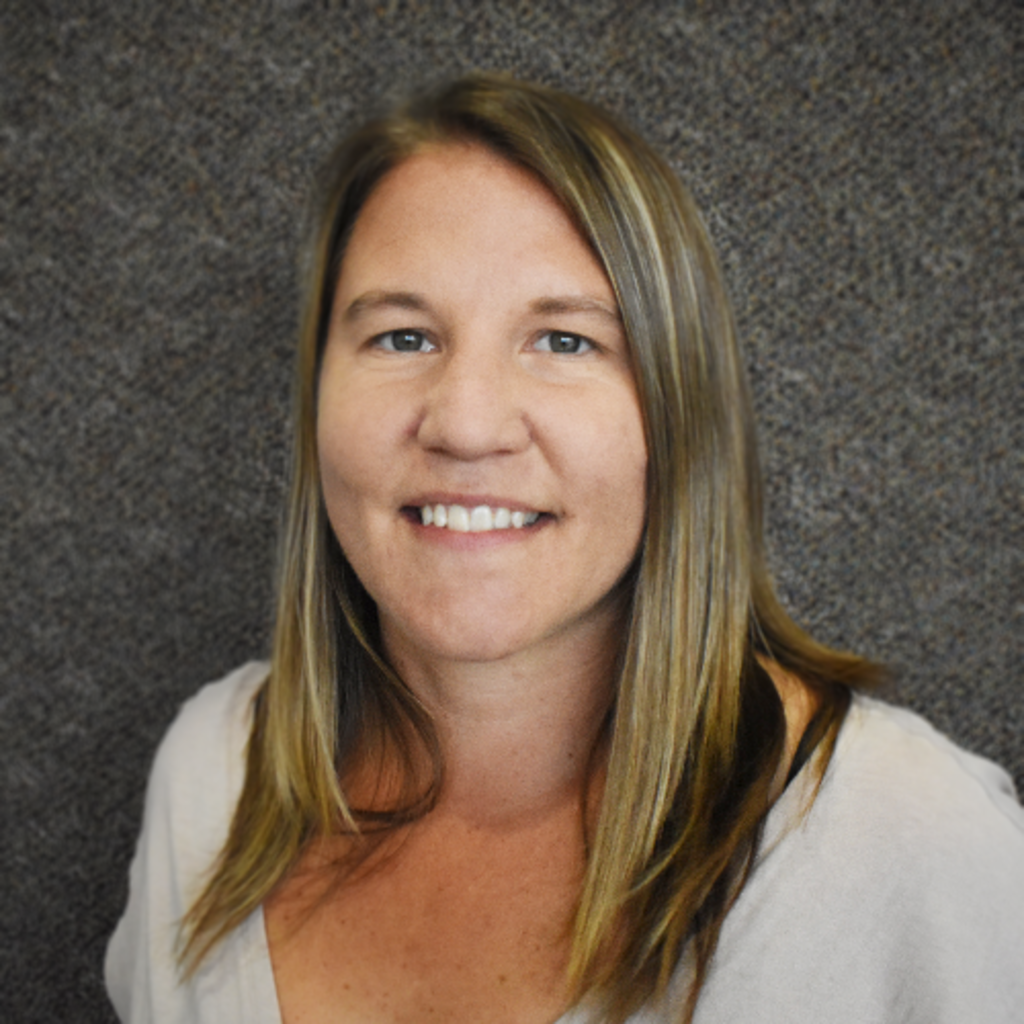
First-Year Seminar: A Tour of Biological Anthropology
Lara Noldner | Bioarchaeology Director Instructor
Students explored the diverse field of biological anthropology and learned about many of the ways that knowledge of human biology can inform us about how people have evolved, migrated, and adapted to the many regions of the world we now inhabit. [Fall 2021, 12 students]
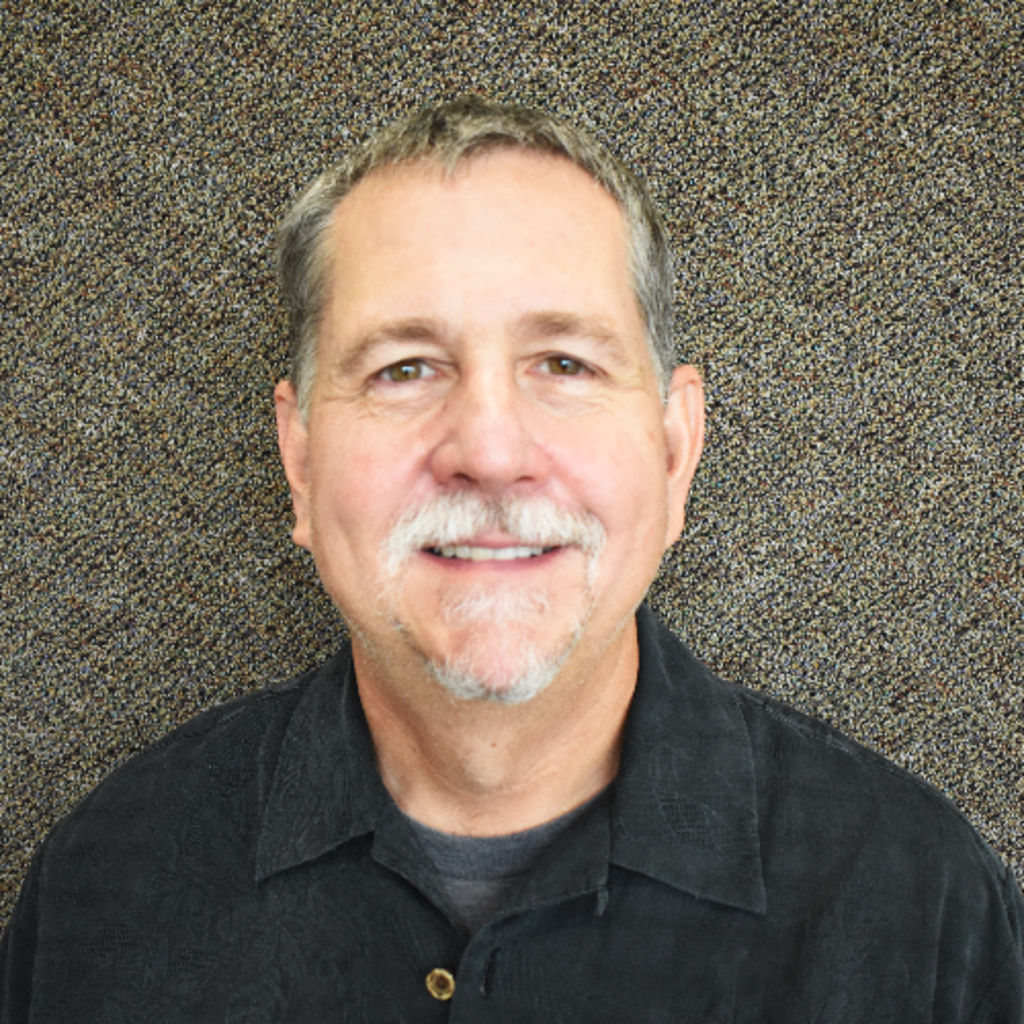
Archaeology of the American Midcontinent
John F. Doershuk | State Archaeologist Instructor
This online course explored the past beyond what historical documents reveal. Students learned about regional archaeological data in addressing culture change issues to develop the essential grounding for understanding how people lived in different times and places in the past, and how precontact peoples relate to their modern descendants across the midcontinent. [Fall 2021, 16 students]
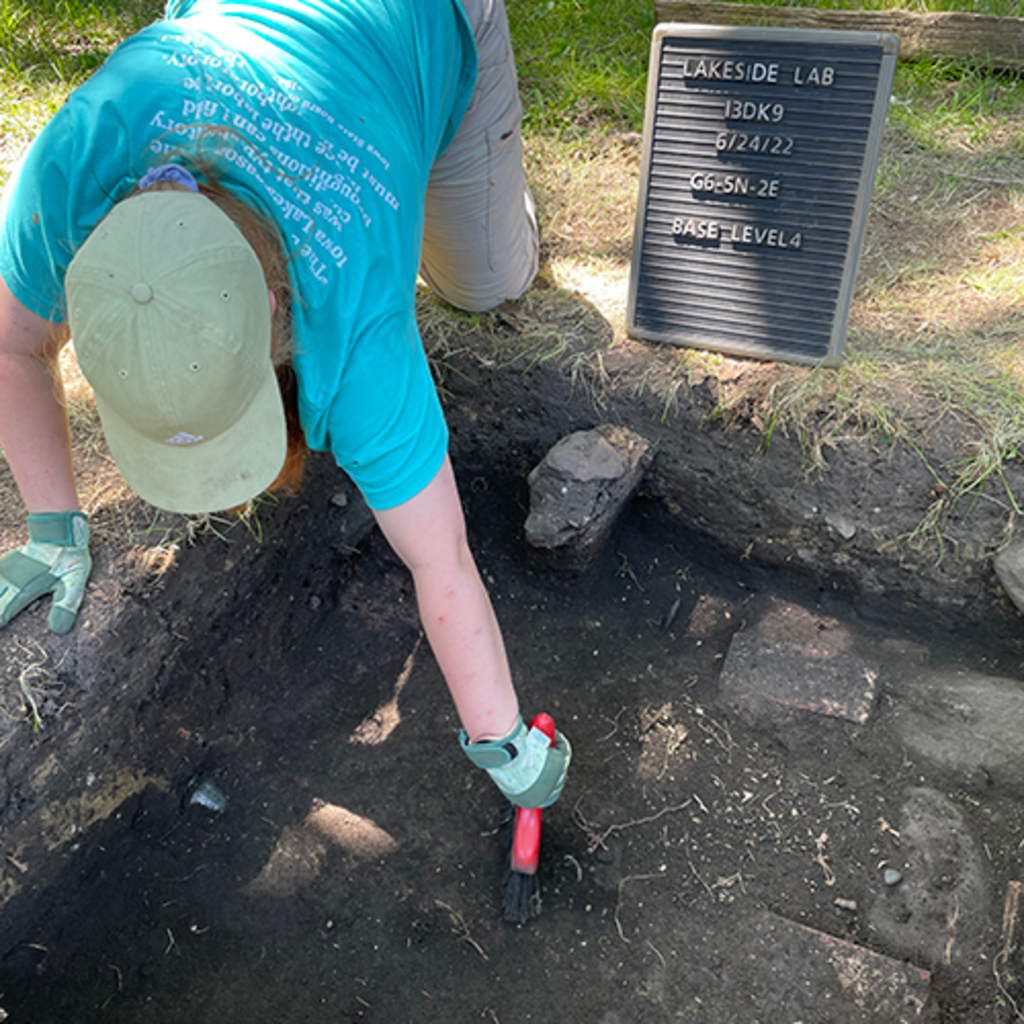
Field Archaeology
The 2022 Lakeside Laboratory archaeological field school included students from UI, ISU, and UNI who investigated a portion of 13DK9, the Abbie Gardner Sharp Cabin Historic Site located in Arnold’s Park on the shores of West Okoboji Lake. The students discovered copious artifacts related to Abbie’s late nineteenth-early twentieth century use of the cabin as one of Iowa’s first heritage tourism locations. The Lakeside Lab Summer 2023 field school will continue work at this important site. [Summer 2022, 8 students].
OFFICE & STAFF ACHIEVEMENTS
Linda Langenberg Retires

Following 35 years of dedicated support for OSA activities (and a remarkable total of 56 years as a UI employee), Linda Langenberg retired at the end of FY 2022. Linda ably assisted three State Archaeologists (Green, Pauls, and Doershuk), as well as Steve Lensink during his two terms of being interim State Archaeologist, providing much appreciated administrative expertise. Linda processed an endless stream of HR appointments, documented financial transactions and prepared bank deposits, tracked reporting of hours by part-time employees, coordinated OSA Advisory Committee meetings and special events, and worked closely with the leadership of the Iowa Archeological Society. Linda was well-known as OSA’s go-to person for any questions about the workings of the University, and always knew who to call to get needed answers. All of OSA wishes Linda the best in her retirement!
Lake Delhi Creative Mitigation
The Memorandum of Agreement (MOA) created to resolve Section 106 compliance issues remaining from the 2010 Lake Delhi Dam catastrophic failure was completed in FY 2022. In partnership with several Tribes, the Combined Lake Delhi Recreational Facility and Water Quality District, State Historical Preservation Office, Federal Emergency Management Agency, Iowa Homeland Security and Emergency Management Division, and the Lake Delhi Recreational Association, OSA created a comprehensive web resource using Lake Delhi as a case study for improved Section 106 compliance and Tribal consultation. Highlights of the web resource are eight newly produced videos providing background and historical context about the project and four videos featuring advice from Tribal partners and agencies regarding Section 106 and Tribal Consultation. In addition, OSA developed and installed six public information signs at key locations around Lake Delhi to educate about the area’s heritage and established a conservation easement protecting four archaeological sites.
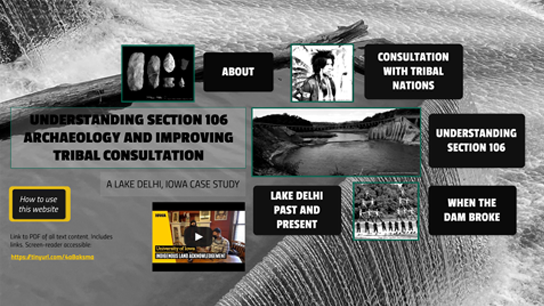
OVPR Community Engaged Scholarship Grant
In spring 2022, OSA assembled a team including the UI Department of Anthropology, the Sac and Fox Tribe of the Mississippi in Iowa (Meskwaki), and Elgin Historical Society (EHS) to support a community-based grant initiative funded by the University through the Office of the Vice President for Research. The $50,000 award was awarded June 1 and the grant activities will be carried out during FY 2023. It includes support for EHS, the Meskwaki, several OSA staff members, and four UI Anthropology undergraduates earning their Museum Studies certificates to design, document, publicize, and participate in two public events to be held in Elgin (October 2022 and April 2023). The events will provide area residents with an opportunity to share their archaeological artifact discoveries and historical family stories about interacting with Native Americans while learning about continuing Tribal interest and appreciation for northeast Iowa.
Microscope Upgrade and Microwear Training
OSA Research Archaeologist Veronica Mraz was awarded a highly competitive UI Arts and Humanities Initiative grant to transform the $32,000 paperweight sitting next to her desk (a.k.a., the 50x–500x compound microscope with 100x–200x camera) into a functional research tool. The grant supported Veronica’s week-long training with one of the nation’s top use-wear analysts in Tulsa. The training and microscope updates open up an exciting new line of lithic research opportunities for the OSA, Veronica, and UI Anthropology students.
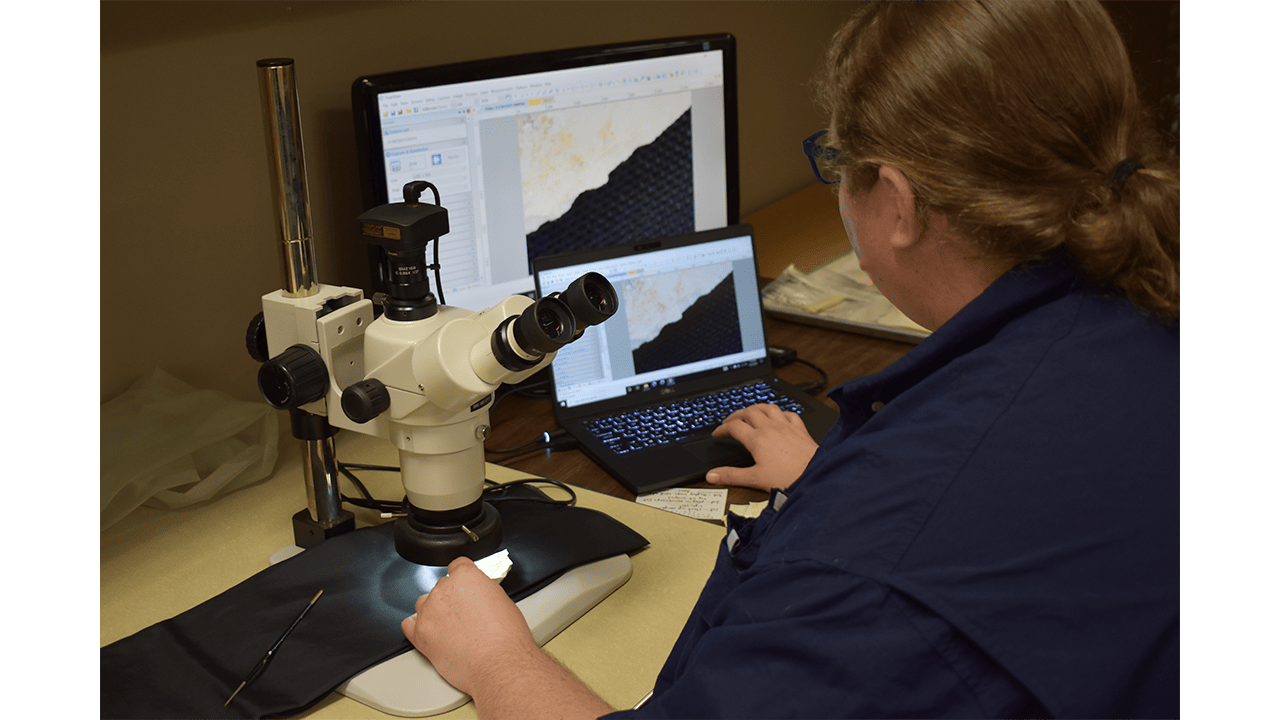
Al Becker Inducted into the Iowa Volunteer Hall of Fame
Alan Clyde Becker, a long-time partner with the OSA in historic preservation, was recognized in a ceremony at the State Capitol as a new inductee to the 2021 Iowa Volunteer Hall of Fame. Becker was a leader in archaeological historic preservation for more than 30 years keeping historical sites alive and thriving. In addition to dedicating countless hours identifying and assessing sites related to the Winnebago/Ho-Chunk occupation in Iowa, he also was deeply committed to partnering with local tribal communities for preservation projects, inviting them to field visits, community lectures, and to provide insight and feedback. Becker has held multiple roles in organizations in the Fort Atkinson area including Fort Atkinson Preservation Committee, Fort Atkinson City Museum Committee, and the Friends of Fort Atkinson’s Fort Atkinson Rendezvous Committee.
Kendall Family PEZ Collection Featured at UI Pentacrest Museums
OSA Research Archaeologist Bryan Kendall and his wife, Erin, have been collecting PEZ candy dispensers as a family hobby for decades. Their collection, numbering the hundreds and spanning the last 70 years of popular culture, was selected by the UI Pentacrest Museums as part of their University Staff and Faculty Member featured collections program. More images available on the UI website.
BY THE NUMBERS
62
years the OSA has
served Iowa and
Midwest region as a
UI research center

62
staff members and
adjunct researchers
worked for OSA
during FY 2022

$ 3,021,884
US dollars OSA received in
support from sponsored
grants and contracts

1 %
is how much gifts
and endowments
contributed to the
OSA budget
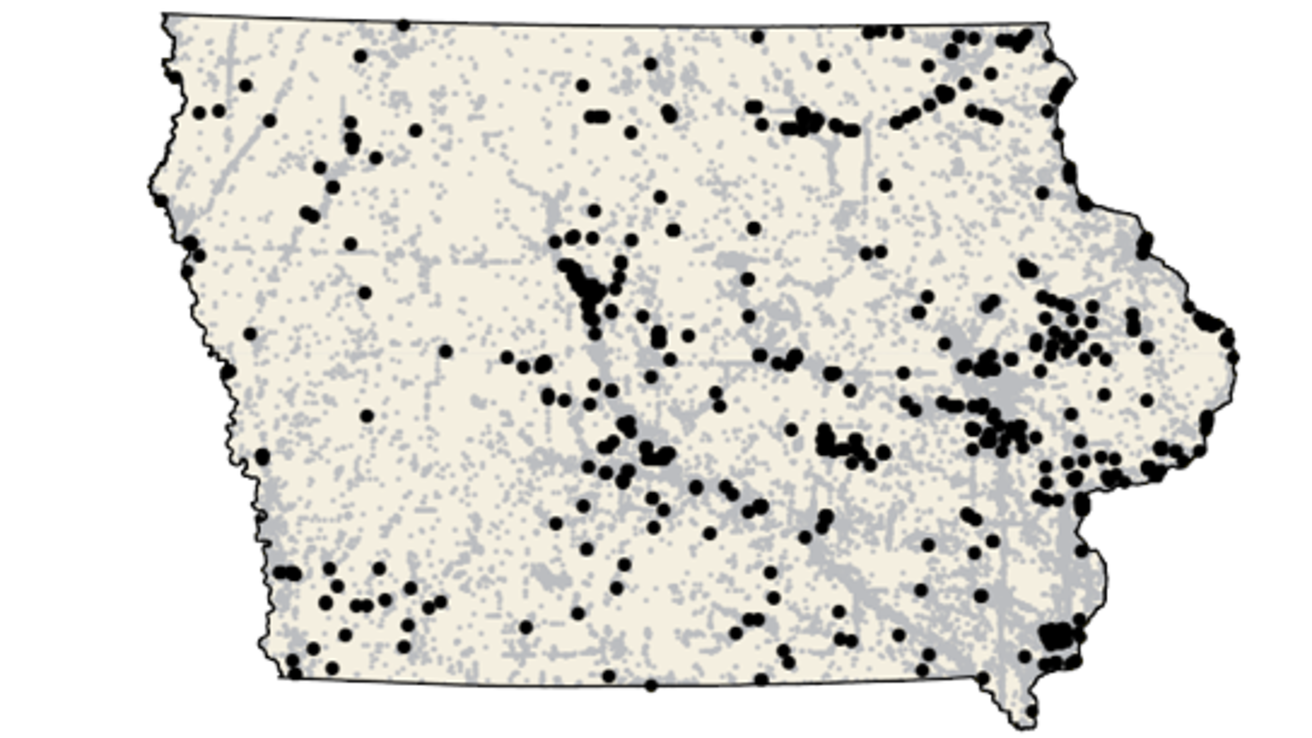
31,304
archaeological sites
recorded by the end
of the fiscal year
190
collections were
newly accessioned
during the fiscal year
2,935
volunteer and student
hours contributed to
OSA projects
2,800 +
people engaged
through OSA
and archaeology
events
STUDENT & VOLUNTEER SUCCESS
Many OSA staff members mentor students and train and supervise student workers, interns, and other volunteers. The OSA actively supports undergraduate and graduate student use of its archaeological, osteological, and comparative collections; scholarly documents; electronic databases; scientific instrumentation; and laboratory space for degree-related research. These resources contribute to the educational experience of students in diverse UI departments including,
- Anthropology
- Art & Art History
- Classics
- Earth and Environmental Sciences
- Economics
- Geographical and Sustainability Sciences
- History
- Law
- Native American & Indigenous Studies, and
- Museum Studies
In FY 2022 the OSA facilities, collections, and staff provided classroom enrichment and workplace experience for a total of 15 faculty, staff, and students and four member of the public who worked to log 2,935 hours at the OSA contributing to project activities.
Participating Institutions:
- University of Iowa
- Cornell College
- Southern New Hampshire University
- Regina High School, Iowa City
- Iowa Archeological Society

Pearl Tyler and Sierra Bergo processing flotation sample.

Sierra Bergo and Noah Egge picking flotation samples.
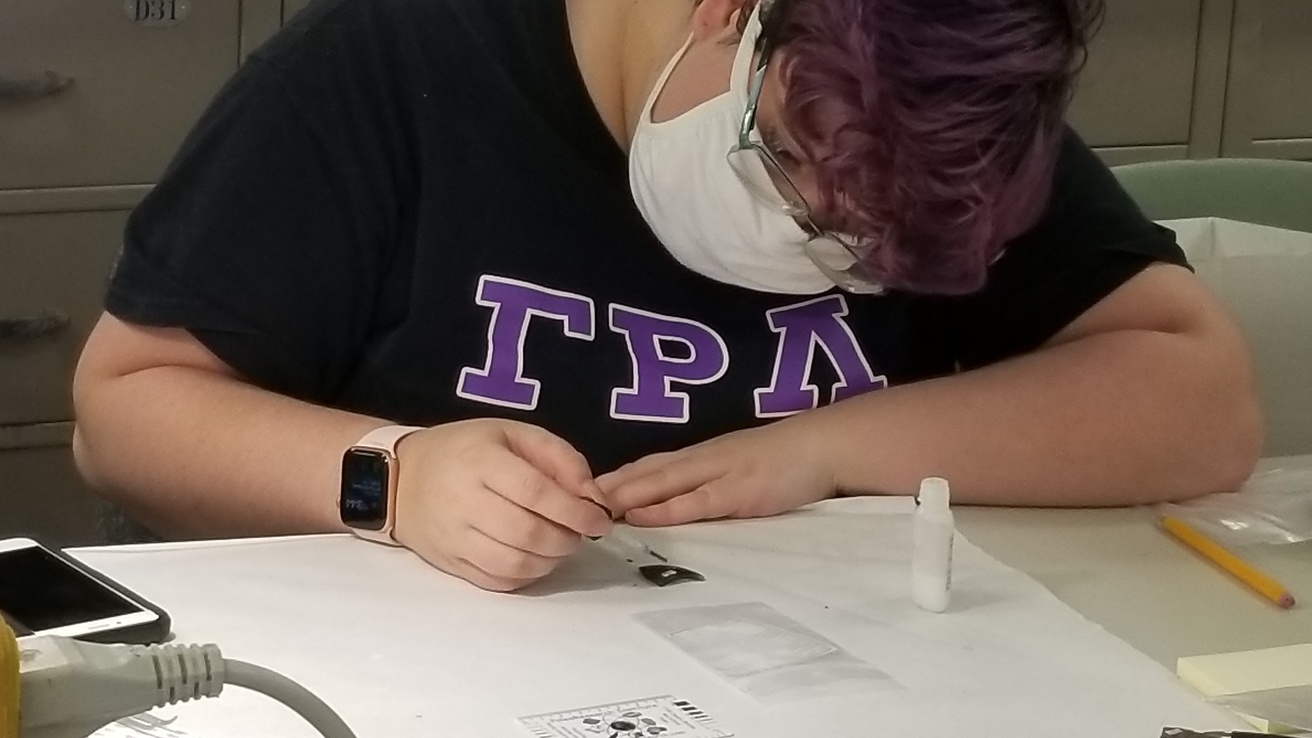
Meghan Schilla labeling artifacts.
Beginning in June 2022, OSA hosted an 8-week Humanities for the Public Good summer intern, Rebekah Erdman. Rebekah is a Ph.D. student in Musicology and has background experience with collections, archives, and organization. OSA tasked Rebekah with strategizing much needed updates and a new way for the public and researchers to digitally access and utilize the Lithic Raw Material Assemblage. She interviewed 19 professionals and members of the public and researched various web-based map and archive platforms to guide her strategy.
RESEARCH
ARCHAEOLOGICAL & ARCHITECTURAL INVESTIGATIONS
The OSA conducts both contract and grant-funded research involving archaeological and architectural history studies statewide. These projects, regardless of funding source or sponsor, generate important new knowledge about precontact and historic era Midwestern adaptations, and they form the basis for many staff publications, professional and public presentations, and student and faculty research projects.
Infrastructure Surveys
The OSA conducted 300+ archaeological and architectural projects in FY 2022, significantly contributing to the enhancement of statewide economic development. In addition to desktop evaluations, 45 projects were for communication, 29 for development, 33 for recreation, 6 for roads and bridges, 15 for marshes and wetlands, and 45 for water improvements.
Iowa Department of Transportation
FY 2022 marks 52 years of contracted services with the Iowa DOT for archaeological investigations and 33 years of historic architectural evaluations. A total of 99 Phase IA Cultural Resource Evaluation reports was submitted, along with four Primary Roads reports pertaining to two archaeological surveys and one historic architectural survey. Among other efforts, the OSA conducted an obsidian sourcing study for Iowa obsidian artifacts using the University of Iowa’s portable X-ray fluorescence (pXRF) spectrometry machine.
Architectural History
In anticipation of building renovations, OSA’s architectural historians preliminarily assessed a 1961 addition to the Iowa State Highway Commission Office Building. The building was assigned a preliminary evaluation of eligibility for listing in the National Register of Historic Places for its importance in the history of the Iowa State Highway Commission (now the Iowa Department of Transportation) and as an unusually intact example of a mainstream International Style (“Mid-Century Modern”) office building.
Archaeology
An archaeological survey at Hitchcock Nature Center in Pottawattamie County discovered additional artifacts from a precontact archaeological site 13PW348 and redefined its boundary to include the likely location of ancient human burials. Human burials older than 150 years old are legally protected in Iowa where precontact burial mounds and unmarked cemeteries are preserved whenever possible. As a precaution any additional earthmoving work planned for the area around the site should be monitored by an archaeologist to ensure proper care is taken if burials were to be encountered.
Railroad Worker's Camps Archaeological Survey
The Milwaukee Railroad Shops Historic District is listed on the National Register of Historic Places and owned by the Siouxland Historical Railroad Association. While much is already known about the history of the complex and its buildings, very little has been recorded about those that constructed the buildings. An archaeological survey was conducted by the OSA in April 2022 with assistance from several community volunteers to locate traces of the camps where many of the workers lived between 1916 and 1918.
Enthusiastic volunteers of all ages from near and far convened in Sioux City to participate in pedestrian survey collection, subsurface testing with augers, as well as washing artifacts after they were collected. This professional-volunteer event was funded through a Historic Resource Development Program grant to the Siouxland Historical Railroad Association. Analysis of the findings is ongoing.
Archaeological Site Testing at Backbone State Park
OSA Research Archaeologist Veronica Mraz assessed archaeological site 13DW50 at Backbone State Park on behalf of the Iowa Department of Natural Resources to determine its eligibility for the National Register of Historic Places (NRHP). For the month of April 2022, a half dozen crew braved inclement spring weather to excavate the site with 12 test units and 120 auger tests. Findings revealed a precontact lithic workshop along with a 1930s Civilian Conservation Corps (CCC) barracks building complex documented in archival photographs. Because of the mix of components indicating a lack of stratigraphic integrity, the site was recommended as not eligible for listing in the NRHP. Among the featured artifacts recovered include a mostly intact projectile point likely made thousands of years ago and a head of a hammer tool used by CCC workmen.
RESEARCH COLLECTIONS
The OSA continually adds archaeological materials and related documents to the State Archaeological Repository and provides materials for local, regional, and national exhibition and research purposes.

190
collections accessioned
this fiscal year
8
collections loaned
this fiscal year
294,551
total records
94 %
available digitally
on iArc

Loans
During FY 2022, OSA loaned artifacts from 17 accessioned collections representing material from 15 sites archaeological sites to individuals from the University of Iowa, Iowa State University, and Cornell College. The majority of artifacts were loaned for archaeological research and analysis. Some material is currently on display at the University of Iowa Pentacrest Museums’ Exhibit 175 Years on the Pentacrest: Then & Now.
Collections
Over 138 accessions from at least 121 sites were accessed in FY 2022. Users of these collections included 16 individuals with a range of affiliations such as the OSA, Illinois State University, the University of Iowa Pentacrest Museums, the Iowa Department of Transportation, and the Des Moines Register. These individuals used the collections for archaeological research projects, educational outreach, and exhibition.
In January of 2022, the OSA received a large collection of artifacts from the family of the late Jimmie Thompson, an avocational collector and long-time Iowa Archeological Society member. This collection includes surface-collected artifacts from over 200 sites in central Iowa, many of which Thompson registered with the OSA in the 1990s. Approximately 10% of the donated materials lack provenience information. The unprovenienced materials will supplement the OSA’s comparative and teaching collections.
The faunal comparative collection gained four species of fish and a Carolina parakeet. These specimens were contributed and processed by Pat Collison, an OSA volunteer, and John Cordell, former OSA Research Collections Director, respectively.
Archives
OSA’s archives program supported four work study students and one part-time staff in FY 2022, ramping back up after impacts from the pandemic. Led by Teresa Rucker, the archives team added 11,621 new records to iArc, including reports, books, conference papers, manuscripts, journal articles, newspaper articles, and photographs. iArc continues to be vital to research at OSA and outside agencies, firms, and individuals.
Teresa continued her service on the Society for American Archaeology’s (SAA) recently formed Archives Committee. The committee is tasked with creating a documents retention and destruction policy to aid the SAA in determining what to curate at the National Anthropological Archives (NAA). She also presented on the creation of iArc at the 87th Annual Meeting of the SAA last April in Chicago.
BIOARCHAEOLOGY
46
Iowa counties represented
in FY 2022

15
Ancient burial site
investigations/reports
64
Consultation for
development projects

18
Inadvertent discovery
investigations
NAGPRA Work
This year the Bioarchaeology Program completed five reburials of ancient human remains in collaboration with 26 tribes that trace their heritage to Iowa and established two additional reburial cemeteries. Two Notices of Inventory Completion were also published in the Federal Register for individuals originally interred in what are now Illinois and Indiana.
Other Projects
The Bioarchaeology Program carried out its usual work with landowners who serve as site stewards, and local, state, and federal agencies in upholding our responsibilities for ancient burial site and inadvertent discovery investigations and reporting, and the protection of sites potentially impacted by development.
We also secured a contract for a statewide survey of post-contact Indian cemeteries in Minnesota; archival research is underway to inventory as many unmarked/unrecorded cemeteries in the state as possible. In consultation and collaboration with descendant communities the main goal of this project is to foster the protection of these sacred spaces through comprehensive documentation.
The OSA hired a new Bioarchaeologist, Sam Murphy!
STRATEGIC INITIATIVES
The OSA provides resources and opportunities that encourage the understanding, appreciation, and stewardship of Iowa’s archaeological past. Digital outreach remained common as the pandemic continued, and OSA staff reached over 500 people live via Zoom and live streaming. Over 5,700 people continued to watch outreach talks after the livestreams aired.
Exploring Iowa Archaeology in K-12 Education
A total of 311 K–12 students participated in in-person and virtual archaeology presentations, activities, and tours with OSA staff.
Educators continued their long-time, award-winning Exploring Iowa Archaeology in the K–12 Classroom presentations virtually.
Beyond the classroom, the OSA staff promoted Iowa’s education program successes and contributed to the field education on a national level through:
- Serving as the Society for American Archaeology’s Public Education Committee chairperson
- Serving on the Project Archaeology National Leadership Team
Iowa Arts Council American Rescue Plan Humanities Grant
The Strategic Initiatives program was awarded a grant from the Iowa Department of Cultural Affairs for the project, “Supporting Statewide Capacity for Archaeological Humanities Programming.” This allowed OSA to hire a staff member to support operational archaeology education activities to align with the Iowa Code and OSA’s mission. At the height of the pandemic, OSA suspended the distribution of Archaeology Discovery Trunks due to unknown factors about how the coronavirus spread. The new Humanities Education Assistant, Meagan Thies- Sauder, worked on much needed updates to these resources. Each Discovery Trunk now has a full-color content guide that also provides background information on each item to assist educators with lesson and activity planning. Educators who checked out the Discovery Trunks in FY 2022 used the resources to reach nearly 500 K-12 youth. Meagan also completed closed captions updates on 16 videos in OSA’s YouTube catalog, which finalized the process to align the entire collection to ADA compliance standards.
With these grant funds, Meagan also assisted Angela Collins and Cherie Haury-Artz with a volunteer archaeology field project at the Sioux City Railroad Museum. This project was wildly popular and attracted over 70 unanticipated youth participants. The Sioux City Railroad Museum staff reported that they could not have gotten through this event as easily without Meagan’s assistance in managing a very large group of excited youth.
Bringing Archaeology to Iowa Communities
Engaging with the Interested Public through Virtual Programming
The OSA continues to foster strong relationships with heritage preservation organizations across the state. After a hiatus due to the pandemic, Project AWARE recommenced with over 300 volunteers in July 2021 on the Middle, South, and North Raccoon rivers in central Iowa. OSA participated as “resident archaeologists” and gave two educational programs at the event. The History and Culture tent at the Meskwaki Powwow was once again canceled due to pandemic concerns, but OSA continued to expand and improve their virtual outreach in addition to ramping back up in-person events. Major events for in-person presentations by OSA staff were the Iowa Archeological Society (IAS) spring meeting at Jester Park Nature Center in Polk County, which also involved a commemoration for David Gradwohl and Don Wanatee; the autumn groundbreaking ceremony and spring volunteer excavation at the Sioux City Railroad Museum, and public presentations that occurred during the IAS field school at Whiterock Conservancy.
Connected for Life: Object-based Digital Programming to Foster Active Minds for Senior Living Communities
The Connected for Life project, supported by a grant from the Institute of Museum and Library Services under the Coronavirus Aid, Relieve, and Economic Security (CARES) Act, continued to thrive during FY 2022. During this time, the partnership of presenters from OSA, Stanley Museum of Art, UI Libraries, and Pentacrest Museums reached 556 participants at senior living communities and senior centers in Iowa via 67 Zoom programs. The team continued to add themed pages with photo galleries to the project website. OSA completed an additional for-the-public interactive archaeology resource, The Meskwaki Talking Papers, that highlights high quality imagery of objects in OSA collections.
Iowa Archaeology Month
Iowa Archaeology Month was primarily virtual again this fiscal year, and the highlight was a live stream series. Five Iowa archaeologists gave live presentations or participated in “Ask Me Anything” Q&A sessions: Colin Betts, John Doershuk, Cherie Haury-Artz, Veronica Mraz, and Lara Noldner. 195 people watched these presentations live and nearly 5,200 watched later on Facebook and YouTube.
@IOWAARCHAEOLOGY
The education and outreach content on the OSA website remained a vigorous, interactive conduit between the public and the OSA. The OSA’s social media pages were an important venue for disseminating news and program information in FY 2022. Active social media platforms administered by the OSA include Facebook, Twitter, Instagram, and YouTube.

5,874 followers, up 841

2,372 followers, up 17

1,511 followers, up 50

13,749 unique views,
up 155 subscribers
On Facebook, the sum of the total daily reach of the Iowa Archaeology page for FY 2022 equaled 80,210, while the total sum of all FY 2022 posts was 271,884. The sum of total daily reach for unique accounts on Instagram was 4,597. The most popular Facebook post announced OSA’s need to hire field technicians; it reached 31,126 people, demonstrating the platform’s powerful potential in terms of engagement and outreach.
Over the course of the fiscal year on Twitter, impressions (the number of times a user saw an Iowa Archaeology tweet) totaled 23,503. The most engaging tweet, seen by 4,726 people, promoted the Iowa Archeological Society field school at Whiterock Conservancy.
On YouTube, people watched Iowa Archaeology videos 13,749 times during FY 2022. How to Sew a Cattail Mat, produced by Liz Schultz and edited by OSA in 2004, remained the most viewed Iowa Archaeology YouTube video this past year and has been viewed over 16,100 times. New to YouTube this year was a series of livestream presentations given during Iowa Archaeology Month.
